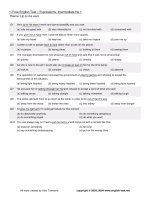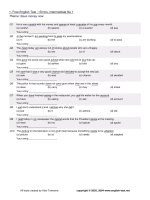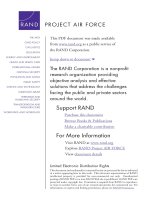Intermediate macroeconomics chapt03
Bạn đang xem bản rút gọn của tài liệu. Xem và tải ngay bản đầy đủ của tài liệu tại đây (400.15 KB, 28 trang )
Chapter 3:
National Income
Production Function
Output of goods and services as a function of factor
inputs
Y = F(K, L)
Y = product output
K = capital input
L = Labor input
Constant Returns to Scale
When an increase in the quantity of the inputs results
in an equal increase in the quantity of the output
F(zK, zL) = zY
where z > 0
Supply of Products
Because we assume that the supplies of capital and
labor inputs and the production technology are fixed,
the supply of product output is also fixed
Y = F(K, L) = Y
Input Price Determination
Input or factor prices are determined by the supply
and demand for them.
Because we assume the input supply is fixed, its
supply line is vertical. The factor demand curve is
downward sloping.
The intersection of demand and supply determines the
factor price.
Input Price Determination
Price
Supply
Equilibrium price
Demand
Quantity
Profit Determination
Profit = Revenue – Labor Cost – Capital Cost
П = PY – WL – RK
P = price of output
W = price of labor input = wage rate
R = price of capital input = interest rate
Production Function
Output
Labor in the variable input
1
MPL
F(K,L)
MPL
1
MPL
1
Labor
Marginal Product of Inputs
Additional productivity gained from hiring an extra
unit of the labor input. MPL and MPK are:
MPL = F(K, L+1) – F(K, L)
MPK = F(K+1, L) – F(K, L)
Diminishing Marginal Product of Labor
As more labor input is added, holding capital input constant, the
quantity of output will increase at a decreasing rate. Hence, MPL
declines, due to inefficiency, as more labor is added.
Units of output
MPL
Units of labor
The Firm’s Demand for Labor
Demand for labor depends on its price and marginal
product
In a competitive market: MPL = W/P = the real wage.
The labor demand is
W = P MPL
The Firm’s Demand for Capital
Demand for capital depends on its price and marginal
product
In a competitive market: MPK = R/P = the real interest.
The capital demand is
R = P MPK
Diminishing Marginal Product of Capital
As more capital input is added, holding labor input constant, the
output will increase at a decreasing rate. Hence, MPK declines,
due to inefficiency, as more capital is added.
Units of output
MPK
Units of capital
Determinants of Demand for Products
The GDP for a closed economy is total spending by
households, firms, and government:
Y=C+I+G
Consumption = C
Investment = I
Government purchases = G
The Circular Flow on Income and Product
Income Payments
Labor Market
Investment
Labor Resources
Financial Market
Saving
Households
Firms
Government Purchases
Government
Taxes
Products
Product Market
Consumption Expenditures
Consumption Function
Consumption is a function of disposable personal
income:
C = C(Y – T)
Y = personal income
T = personal income taxes
Consumption Function
Marginal propensity to consume = additional
consumption from an extra dollar of disposable
personal income
MPC = ΔC / Δ(Y –T)
MPC is slope of consumption function.
Consumption Function
Consumption, C
C = C(Y – T)
MPC
1
Disposable income, Y - T
Investment Function
Investment is a negative function of the real interest
rate
I = I(r)
Low interest rates encourage borrowing for
investment purposes, whereas high interest rates
discourage borrowing
Investment Function
Real interest rate, r
I(r)
Quantity of investment, I
Government Role
We assume government purchases of goods
and services and resources and personal
income taxes are fixed amounts:
G=G
T=T
National Income Identity
Y = C + I + G, where
C = C(Y –T)
I = I(r)
G = G and T = T
Y = C(Y – T) + I(r) + G
Saving Investment Identity
Equilibrium in the product market:
Y = C(Y – T) + I(r) + G
Y - C(Y – T) - G = I(r)
S = I(r)
Where S is national saving
Components of National Saving
Private saving: left over household income:
Sp = Y – T – C
Public saving: left over government revenue:
Sg = T – G
Determination of Real Interest Rate
Real interest rate
S
Equilibrium interest rate
I(r)
Investment, Saving









